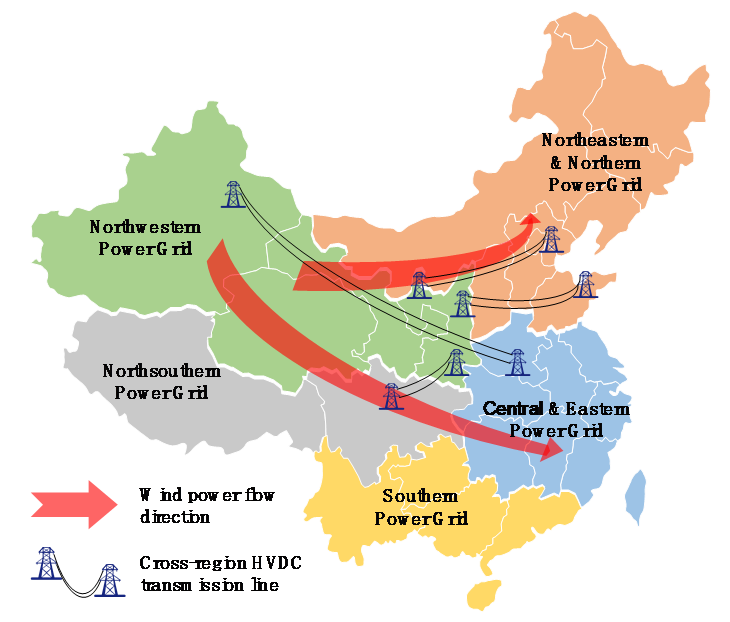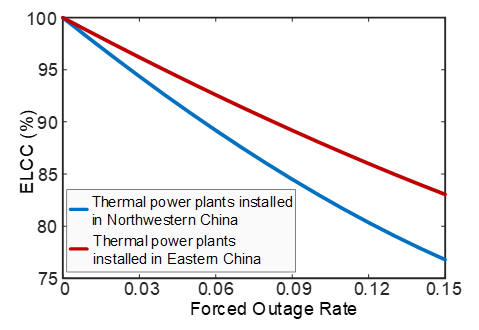Available Capacity Credit of Large Wind Power Development in China
By Mohammad Shahidehpour, Tao Ding, Ming Qu, and Quan Zhou
In 2019, there was an additional 25.74GW of wind power installation in China, of which 23.76GW is the onshore installation. The installed wind power capacity accounts for 10.4% of the installed power generation capacity by the end of 2019. The wind power generation in China has reached 405,700GWh in 2019 accounting for 5.5% of the total generated energy. The proliferation of wind power generation in China has brought about green energy, diversity of the national energy portfolio, and reduced carbon emission. The deployment of variable renewable energy has also posed an enormous pressure on power grid operations and the reliability of power delivery. Hence, it is imperative to determine the available capacity credit of variable wind power generation considering its rapid development in various parts of the world.
Effective load carrying capability (ELCC) is a metric to measure the capacity credit (i.e., a portion of the rated capacity which is guaranteed to be available should it be needed). of power plants. ELCC is regarded as a derating factor applied to the power plant’s maximum capacity which considers uncertain factors such as forced outage rate (FOR) of thermal units and variability of renewable energy units in determining the plant’s actual value to satisfy the power grid’s reliability requirements. For example, a coal-fired thermal generator with a relatively low FOR will have a high ELCC value, representing a large percentage of its nameplate capacity. Conversely, a thermal plant with a larger FOR would possess a smaller ELCC in power system reliability studies. The ELCC of wind power generators (which depends on the availability of wind) might range from 8% to 45%, which is much lower than those of conventional thermal generators. Also, the wind power generator’s ELCC is correlated with load profiles. If the correlation is high, the ELCC of wind power generators would also be high since the wind power generation is available when it is most needed. However, a low correlation with load profile corresponds to a low ELCC, representing a lower capacity credit when the wind power generation is mostly needed.
In China, large-scale wind farms are often separated geographically from load centers. In 2019, the national average wind power utilization was 2082 hours and the amount of wind curtailment was 16,900GWh. The large-scale wind power generation available in Northwestern China is transported to the Eastern load centers by high-voltage direct current (HVDC) power transmission lines, which signifies the regional disparity of wind power generation and load centers in China, as shown in Figure 1. Compared with AC transmission, HVDC transmission features lower active power losses, higher flexibility and reliability, and the capability of limiting short-circuit currents. However, one would have to consider the effects of FOR and losses of HVDC transmission lines are important considerations when calculating the ELCC of wind power generators. ELCC, which uses the variability of wind as a parameter, provides a more effective and accurate metric to guide future wind power capacity installations and facilitates the inclusion of variable wind power generation capacity in reliability studies.

Figure 1: Large-scale wind power flow from Northwestern China to Eastern China via HVDC transmission lines.
We start our analysis by assuming that the Eastern region load is supplied only by thermal generators. Figure 2 depicts the ELCC of thermal power generation when the FOR of HVDC transmission line is considered. In Figure 2, when the FOR is zero, thermal units can potentially be installed in either Northwestern or Eastern China with the same level of ELCC. However, when the FOR of HVDC transmission is increased from 0 to 0.15, the blue and red lines begin to split. In this case, the thermal power capacity installed in Eastern China will have a higher capacity credit considering the random outages of HVDC transmission. Thus, the availability of HVDC transmission will have a major impact on the ELCC of thermal power generation installed in Northwestern China. In this case, the ELCC analyses can properly assess the actual value of installed thermal power generation to the power grid as depicted in Figure 2.
Figure 2: ELCC of thermal power generation installed in the Northwestern and Eastern Regions of China.
Now, we shift our discussion to the effect of wind availability, and HVDC transmission line FOR and losses on ELCC of wind power generation. Northwestern Chinese provinces Xinjiang and Gansu have abundant wind resources but are located far from load centers in Eastern China. By the end of 2019, the cumulative installed wind power generation capacity in Northwestern China was 53.63GW with a total energy of 97,600GWh. Thus, one critical decision is whether wind power generation units should be located in Northwestern China where wind resources are richly available and yet the power delivery to Eastern load centers is subject to the HVDC transmission. The alternative would be to locate the wind power generation units in Eastern China where the wind resources are less attractive but the wind power generation is not subject to HVDC transmission outages and losses.
Figure 3: ELCC of newly installed wind power generation in Northwestern and Eastern China regions.
Consider the case in Figure 3. In Figure 3(a), where the FOR of HVDC transmission line is not considered, the blue line depicts the ELCC of the newly installed wind power generation in Northwestern China for supplying the load in the Eastern region. The results in Figure 3(a) suggest that if FOR is not considered, it would be more desirable to install the wind power generation units in the Northwestern region (where the wind is stronger) and transfer the wind power generation via HVDC transmission lines to the Eastern region. In Figure 3(a), the ELCC of the blue line increases to 59GW with a newly installed wind power generation unit capacity of 200GW. Likewise, the red line, which depicts the ELCC of the newly installed wind power generation units in Eastern China, provides an ELCC of 49GW with an installed capacity of 200GW. Since Northwestern China features higher wind resources, the blue line in Figure 3 is always above the red line, implying that Northwestern China is the preferable site for the installation of additional wind power generation.
Figure 3(b) shows the ELCC of wind power generation when we consider the impact of the availability of HVDC transmission lines and wind power generation units. In this case, both blue and red lines depict lower ELCCs. Also, blue and red lines cross when the newly installed wind power generation capacity reaches 140GW. Accordingly, additional wind power generation should be installed in Northwestern China if the planned capacity is lower than 140GW. Otherwise, the Eastern China installation will offer a higher capacity credit for the additional wind power generation as depicted in Figure 3(b). The inclusion of both the availability of wind resources and the reliability of HVDC transmission in the calculation of ELCC reveals the true value of the newly installed wind power generation to the power grid. Also, Figure 3(c) indicates that HVDC transmission losses will further reduce the ELCC value as additional wind power capacity is installed. The HVDC transmission losses take a quadratic form in the ELCC calculation for the newly installed capacity. Therefore, the corresponding crossing point in Figure 3(c) is below that of red and blue lines. Our ELCC method provided a quantified value of the corresponding capacity credit when uncertain units are installed, indicating that grid operators should focus their analyses on the capacity credit based on ELCC rather than the nameplate capacity of individual units.
This article edited by Geev Mokryani
For a downloadable copy of the September 2020 eNewsletter which includes this article, please visit the IEEE Smart Grid Resource Center.




To have the Bulletin delivered monthly to your inbox, join the IEEE Smart Grid Community.
Past Issues
To view archived articles, and issues, which deliver rich insight into the forces shaping the future of the smart grid. Older Bulletins (formerly eNewsletter) can be found here. To download full issues, visit the publications section of the IEEE Smart Grid Resource Center.






